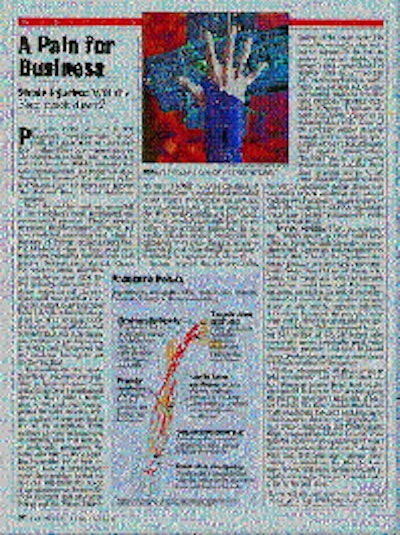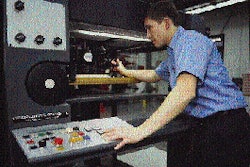OSHA has a split personality these days. On one hand, the federal workplace watchdog continues to drop fines like bombs on some companies. On the other hand, the Occupational Safety and Health Administration has inaugurated high-visibility pilot programs in a number of states aimed at getting companies to voluntarily upgrade workplace safety in return for seeing their names put at the bottom of the inspection priority list. No one is accusing OSHA of being too nice, at least not yet, and certainly not Alfred Teo, president of Alpha Industries (Lyndhurst, NJ), whose subsidiary, Omega Plastics Corp., received a $1.386 million fine from OSHA on May 18, 1995 (see sidebar, printing presses). OSHA said the fines were levied because Omega did not have machine guards on its 11 printing presses, which are used to print plastic bags used as packaging for garments, shoes and general merchandise. Perhaps not so coincidentally, the "other" OSHA had shown its accommodating face just two days before. President Clinton had visited Stromberg Sheet Metal Works in Washington, DC to announce a major OSHA "reinvention" program, which consisted of a number of new initiatives, including expansion of the Maine 200 program to other states. After recalling his visits as Arkansas governor to different manufacturing plants, where he joined the workforce for a day, Clinton talked about OSHA's new approach, where companies have a choice. Partnering with OSHA "You can put in place a health and safety program that involves your workers and that tries to find and fix hazards before an accident happens and OSHA will be a partner," the President explained. "But if business chooses not to act responsibly and puts its workers at risk, then there must be vigorous enforcement and consequences that are serious when violations are serious." The Maine 200 program is OSHA's biggest, tastiest carrot these days. It started in 1993. Bill Freeman, the OSHA area director in Maine, took a look at state workmen's compensation figures. He picked out the 200 companies with the worst injury and illness records and offered them a deal: if they did a self-audit, came up with a responsible schedule for fixing workplace dangers and followed through, then OSHA would put the company at the bottom of the "to be inspected" list. Almost all the companies agreed to participate. OSHA's evaluation shows that in two years, the employers self-identified over 95ꯠ instances of hazards, more than fourteen times as many as could have been cited by OSHA inspectors. Since joining the program, six out of 10 employers have experienced a decrease in their lost-time injury rate. OSHA plans to formalize Maine 200 plans in nine other states by the end of 1995. Darcie Libby is the risk manager at Hannaford Bros. Co. Scarbor-ough, ME, a company which volunteered to participate in the Maine 200 program. The company has about 120 grocery stores and three warehouses throughout the Northeast and Southeast. Libby calls Maine 200 "a very positive situation." OSHA had fined individual Hannaford Bros. locations in the past. "Having OSHA involved in a nonvoluntary way can be very painful," admits Libby. "The Maine 200 program felt risky to us at first. It was hard to trust OSHA. But now we are not afraid to call them and get their advice, knowing that our call will not lead to an inspection or citation." Hannaford Bros. is concerned about all of OSHA's standards. But with all the lifting done by its employees, potential ergonomic problems-"case weight and size" chief among them-are at the top of its remediation list. "Today, our warehousemen are involved on a day-to-day basis with identifying product packaging alternatives that would reduce risks," says Libby. "Maybe that would have happened without Maine 200. But not as quickly." 'Focused' inspections Another reinvention initiative announced by President Clinton in mid-May will be an expansion of the "focused" inspection program currently limited to the construction industry. Thus, when a company can prove it has a comprehensive workplace safety program in place, OSHA will confine its inspection to a handful of the potentially most serious workplace hazards. There is no searching for or citations of violations of the more penny-ante OSHA standards. This expanded program was scheduled to be launched in August 1995. James Torgerson, director of corporate safety for Sara Lee Corp., Chicago, IL, says OSHA "is in a state of change." He explains, "OSHA should be a consultant who helps companies improve workplace safety, instead of punishing companies right off the bat. If corrections are not made, or the safety program is not upgraded, OSHA can always come back and issue a citation, and a penalty." Sara Lee was one of innumerable packaging companies whose figurative hair stood on end when OSHA announced a proposed ergonomics standard in August 1992. One OSHA official notes that according to the latest figures from the Bureau of Labor Statistics, there were 302ꯠ new CTDs (cumulative trauma disorders) in 1993, the latest year for which statistics are available. Putting together paperboard boxes by hand, for example, can lead to CTD. Currently, OSHA can cite companies for ergonomics violations under its loosely-worded "general duty" clause. That clause leaves plenty of room for interpretation. Ergonomics retreat On June 12, OSHA Administra-tor Joe Dear retreated on ergonomics under intense political pressure. He said that the agency would discontinue work on the kind of standard it had been proposing, but would move forward with something narrower. He provided no details. Putting an exclamation point on this OSHA turnaround was the resignation June 9 of Barbara Silverstein, the special assistant for ergonomics programs. There were a number of things that had ticked off the business community about the proposed ergonomics standard. Two tripwires would have determined whether a company got roped in: if employees had musculoskeletal disorders in the past or if a job or jobs had what is called a signal risk factor (SRF). With regard to assembling of containers and packaging, this SRF would be "using forceful hand exertions for more than a total of two to four hours (a specific period would have been chosen) at a time. If the company met either of those two thresholds, it would have to go through a checklist having to do with forearm and wrist movements required by the job. If the checklist yielded a score above 5, the company would have to begin an abatement program. Peter Eberle, manager of government and technical affairs for the Foodservice & Packaging Institute, says that one of the major objections to the proposed ergonomics standard was that it would force packagers to waste time looking into jobs that are not problematic. He calls the checklists "a nightmare." However, it should be pointed out that when OSHA previewed its revised ergonomics proposal in March 1995, the agency had softened a number of provisions, including allowing employers to use their own checklists. But those checklists would still have to be approved by OSHA, Eberle says. Cutting the budget Discontent with the proposed ergonomics standard, multiplied many times over, translated into frustrated calls to members of the Republican-majority Congress, who had, since January, been vowing to cut OSHA down to size. The leading complainant has been Rep. Tom DeLay, (R-TX), the House Republican whip, who during the spring had introduced an amendment to a $16 billion "recission" bill. The DeLay amendment cut the current OSHA fiscal 1995 budget by $19.5 million. It also included language prohibiting OSHA from continuing to work on an ergonomics standard. The Senate bill cut OSHA's budget by $6.5 million. The final conferenced bill-which President Clinton vetoed on June 7 for non-OSHA reasons-had no OSHA budget cuts but retained the ergonomics restrictions. Now that language is of no import anyway given Dear's comments on June 12. Congress is unlikely to be sated by OSHA's retreat on ergonomics. Republicans now want a big cut in OSHA's fiscal 1996 budget, which begins October 1, 1995. The Senate budget resolution would cut OSHA's $312 million annual budget by 50% in fiscal 1996. The House resolution contains a 20% cut. Those two versions are now being reconciled by a House-Senate conference committee. Whatever emerges will be used as a guideline by the Appropriations Committees in both houses. They make the final call on the OSHA fiscal 1996 budget. OSHA's Joe Dear says the Senate 50% cut "would devastate OSHA's efforts to fulfill its congressionally mandated mission of assuring safe and healthful working conditions for all Americans." He argues that injuries decline up to 22% in workplaces in the three years following an OSHA inspection. Also, state programs offering free consultations to businesses on OSHA compliance could be wiped out. Personal citations now Not only does Congress want to "taketh away," it wants to "giveth" as well. There are bills that would give OSHA new authority to issue citations to employees for careless behavior, something that might have been useful in the Omega Plastics case. Currently, OSHA can only penalize companies. Ultimately, of course, OSHA regulations can never replace good judgement. Harry Hajinlian, packaging project manager in the specialty foods division of Nabisco Inc., says companies need to use common sense. He notes that back injuries from the lifting of pallets can be reduced if the employees are rotated in and out of that job on a regular basis. Nabisco packaging facilities have to comply with regulations on indoor air emissions, regarding, for example, how much peroxide, which is used to sanitize some packaging webs, gets into the air. He admits that some OSHA standards are ambiguous. "It is better to err on the safe side when questions arise," he advises. He does not have much patience for those people "who want to find someone else to blame." c


























